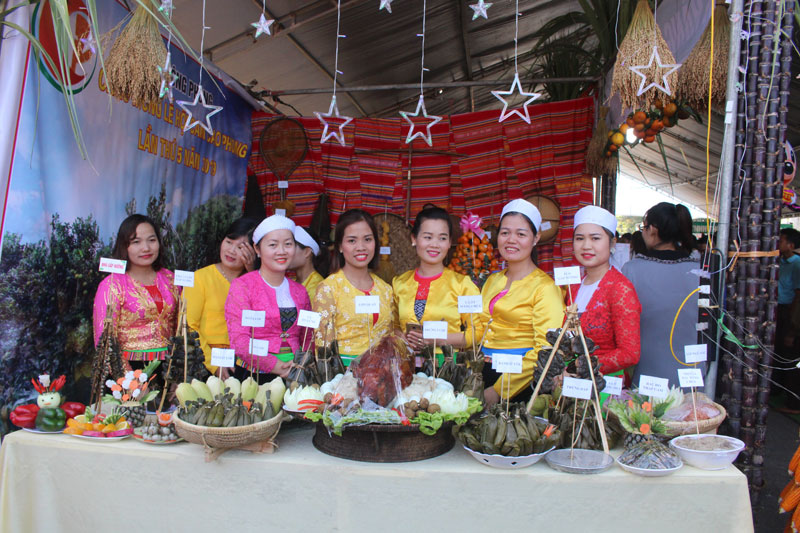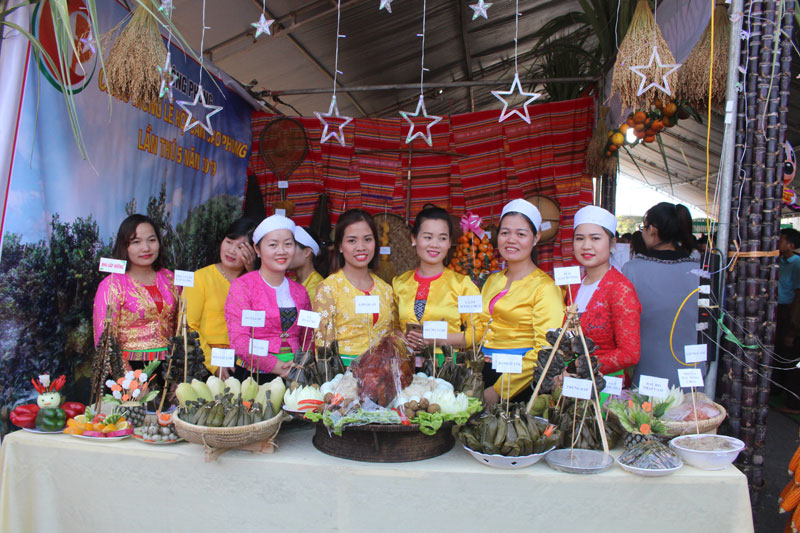
(HBO) - On the occasion of Cao Phong Orange Festival and Cao Phong District Trade Fair in 2019, many visitors are impressed with the activities that are elaborately prepared and lively than the previous festive seasons. Especially, there are galleries of local produce and cuisine that have created new features.
As a result, the festival atmosphere is more
joyful, tourists understand more about the cultural identity, customs and
practices of Muong Thang people - Cao Phong district.
 The
stall displaying culinary and local products at the festival of Dong Phong
commune (Cao Phong district) won the first prize.
The
stall displaying culinary and local products at the festival of Dong Phong
commune (Cao Phong district) won the first prize.
Spending time visiting the product and food
display booths at the festival is truly an unforgettable experience for visitors.
The stall of Thung Nai, Binh Thanh communeattracts visitors with specialties of dried fish, grilled
fish made from clean fish of Da river.
The stall of Xuan Phong and Dong Phong
communes has specialties of Can wine, native pigs, stream fish, natural honey. The stall of Bac Phong commune has cakes made
from upland sticky rice of the Dao people, vegetables, corn, and crabs...
Mr. Bui Van Chung, in charge of the stall of
Xuan Phong commune, said: Many people come to our booth to enjoy traditional. They can drink Can wine, taste the
dishes in the way of processing Muong people. We are happy to introduce the
culinary characteristics of Muong people to visitors.
With elaborate preparations for the activities
taking place at the festival, besides the main products are citrus fruits and
sugarcane, 100% of communes and towns in Cao Phong district have booths to introduce
local cuisine.
Through the festival, promoting the beauty of
culinary culture and products of the region, helping visitors to understand
more about the customs, habits, daily life of Muong Thang people, Cao Phong district, Hoa Binh province.
The clothing of women reflects the culture of the Muong, Thai, Tay, Dao, and Mong ethnic groups in the northern province of Hoa Binh.
Gongs hold a special place in the cultural and spiritual life of the Muong ethnic people in Hoa Binh province. More than musical instruments, they are an indispensable part of community rituals and collective memory, echoing through generations as a spiritual thread linking the past, present, and future.
Preserving and promoting the cultural values of the Muong ethnic group has become an urgent task in the current context, as many traditional values face the risk of fading away. This effort requires not only protecting the cultural identity but also eliminating outdated customs and developing a modern cultural lifestyle, contributing to sustainable values for the Muong community in Hoa Binh province.
The Muong ethnic culture, deeply rooted in Vietnam’s mountainous north, continues to be preserved and revitalised by dedicated individuals and communities determined to safeguard their ancestral identity.
The Muong group is one of the largest ethnic minorities in Vietnam, primarily found in Hoa Binh province. The Muong people in Hoa Binh boast a rich and diverse cultural treasure that reflects the unique identity of this ethnic group. Accounting for over 63% of the province's population, they have created and preserved numerous distinctive cultural values, contributing to their unique identity. Their cultural heritage is an invaluable asset, at the heart of their national identity, and represents a vibrant spiritual life that must be preserved and promoted in today’s modern world.
For generations, the ethnic communities of Hoa Binh province, particularly the Muong people, have preserved vibrant festivals deeply intertwined with the region’s geography, nature, and social traditions. These celebrations enrich Hoa Binh’s spiritual life and cultural identity, reflecting both folk beliefs and the intermingling of ethnic customs. Many of these festivals have endured the test of time, passed down through generations and continuing to thrive today. Among them, the Khai Ha (Going Down to the Field) festival stands out as one of the most significant events of the Muong ethnic group.



 The
stall displaying culinary and local products at the festival of Dong Phong
commune (Cao Phong district) won the first prize.
The
stall displaying culinary and local products at the festival of Dong Phong
commune (Cao Phong district) won the first prize.